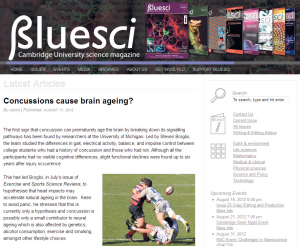WEDNESDAY, 3 OCTOBER 2012
How many generations would it take a mouse-sized animal to evolve into an elephant-sized one? Is a malaria vaccine in sight? And what exactly is dark matter?In articles just a few hundred words long and suitable for a general reader, BlueSci News covers the entire spectrum of science, from immunology to astrophysics.
Being able to take complex information – perhaps on a topic that you previously knew little about — and transform it into clear and readable prose is a skill valued in many fields, both inside and outside science. Especially if you also need to get it done whilst the story is still relevant and interesting and you have to juggle a whole bunch of other pressures, a Cambridge degree for example.
Perhaps the greatest challenge is finding a worthwhile story, new scientific papers are published all the time and each one is a potential story but finding one with high public interest and impact factors is a much more intricate procedure. Often news stories don’t come from the title of a paper, sometimes they are found buried in the discussion or one of the experiments, it takes an inventive and dedicated writer to find these hidden gems and build them into a story.
Furthermore, it’s not just about the text. Whenever you scan a website or flick through a magazine, it’s the headline and the images that pull you in. Giving an article a catchy title and making it look appealing on the page are key considerations and vital skills if you want to get your message across. As the publishing industry moves increasingly towards online content, learning to think about how to attract and keep a reader despite infinite competition, shorter attention spans and busier lives is paramount.
If you’re at all tempted by a career in science communication, or you’d simply like to develop writing and editing skills to help in your thesis or when publishing papers, then preparing an online news story is an excellent way to get started without having to commit a huge amount of time. The skills that you can acquire at BlueSci are particularly highly valued by the publishing industry but also equip you to be successful in academia and industry.
I decided to get involved with BlueSci whilst I was working as a post-doctoral researcher, having realised that I did not want to be an academic for the rest of my career I decided to try out some alternatives. After only a short time working on BlueSci News, I was able to leave my research and took on a new role as sub-editor at Nature. I now work on the ‘front half’ of the magazine, helping to hammer non-research copy (editorials and “news & views” type things) into shape before Tuesday’s weekly press deadline. My new job means that I make constant use of the abilities that I developed and honed at BlueSci.
During my interview at Nature Publishing Group (NPG), it quickly became clear that my answers to most of the questions, for example, “What should a news reporter keep in mind when they prepare a story?”, “Can you give an example of when you’ve had to work to deadlines?”, “What about when you’ve worked in a team?”, “How do you decide whether a story is newsworthy?”, revolved around the experience I’d gained working with BlueSci, and particularly with the news section. And that experience does seem to have helped out over the past few months, too. Most of the principles are the same no matter what the magazine – it’s just the scale and the pace that can differ!
Louisa Lyon was a post-doctoral researcher in the Department of Experimental Psychology and edited BlueSci News during 2011/12. She is now a sub-editor at Nature.
BlueSci news articles can be written about any science story and can be sent to the news editor for online publication. Articles are typically 300-400 words so are very quick and easy to write – even if you have a busy schedule. BlueSci News is now run by Joanna-Marie Howes, contact her on news@bluesci.co.uk to get involved in news writing or editing.

